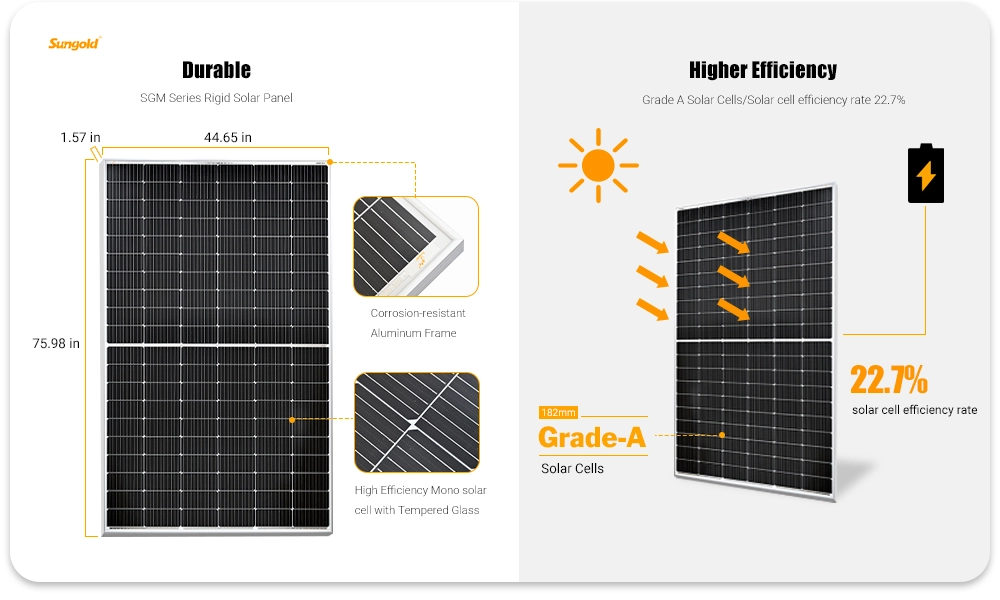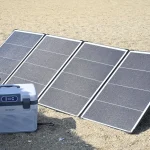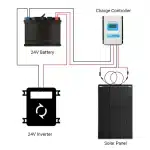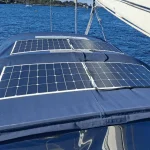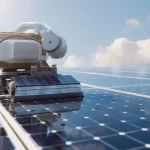Table of Contents
Did you know that solar energy, along with wind turbines, is the fastest-growing source of renewable energy in the world? It is a great alternative to fossil fuels for power systems, especially during peak sun hours. In fact, according to recent studies, the global solar panel market is projected to reach a staggering $189.3 billion by 2025! This growth is driven by the increasing demand for renewable energy sources and the desire to reduce energy bills. This shocking statistic highlights the increasing popularity and importance of solar panel kits in today’s energy landscape, especially in reducing electricity bills and reliance on grid electricity. With the rising costs of utility grid electricity, more people are turning to renewable energy sources like wind turbines and solar panel kits.
If you’ve been considering making the switch to clean and sustainable energy, solar panel kits with micro inverters offer a convenient and cost-effective solution for harnessing wind and generating watts of power on the grid. These solar panel systems kits provide all the necessary components for solar installation to harness the power of the sun and generate electricity for your home or business. Additionally, they include solar batteries to store the energy generated by solar systems. With advancements in technology and decreasing costs, installing solar panels, which are renewable energy sources, has become more accessible than ever before. This is great news for homeowners looking to reduce their energy bills and meet their energy needs. Additionally, the use of micro inverters can further optimize the efficiency of solar panels.
Not only can solar panel kits help reduce your carbon footprint, but they also offer significant financial benefits by lowering your energy bills and providing clean energy to the grid. With increasing energy needs, harnessing renewable sources like wind and solar power is becoming more important than ever. By installing solar power systems and generating your own solar energy production, you can potentially save thousands of dollars on utility bills over time. Many countries provide incentives such as tax credits and rebates for adopting renewable energy systems like solar panels. These systems can be connected to the grid and controlled using a solar panel controller. Taking advantage of these incentives can help individuals and businesses save money on their purchase of solar panels, making it a more affordable option for harnessing the power of the stars.
So, if you’re ready to embrace clean energy and take control of your power consumption with a solar plan, solar panel systems, and solar batteries, keep reading to learn more about maximizing your solar panel output.
How Does a Solar Kit Work?
Solar panel kits with micro inverters are an excellent way to harness the power of the sun and generate clean, renewable energy for your home or business. These kits are designed to connect to the grid and use the stars as a source of energy. With the help of these kits, you can easily install solar panels on your rooftop and start saving on your electricity bills. So, why wait? Augment your energy needs with solar panel kits today! But how exactly do these kits work? Let’s dive into the details and uncover the inner workings of a solar kit with micro inverters. These small devices play a crucial role in converting DC power from solar panels into AC power that can be used by the grid. With their efficient design, microinverters are like the stars of the solar system, ensuring maximum energy production. So, let’s put on our engineering hats and explore the fascinating world of solar kits with micro-inverters. Don’t forget to mark your calendars for the upcoming AUG conference where experts will discuss the latest advancements in solar technology.
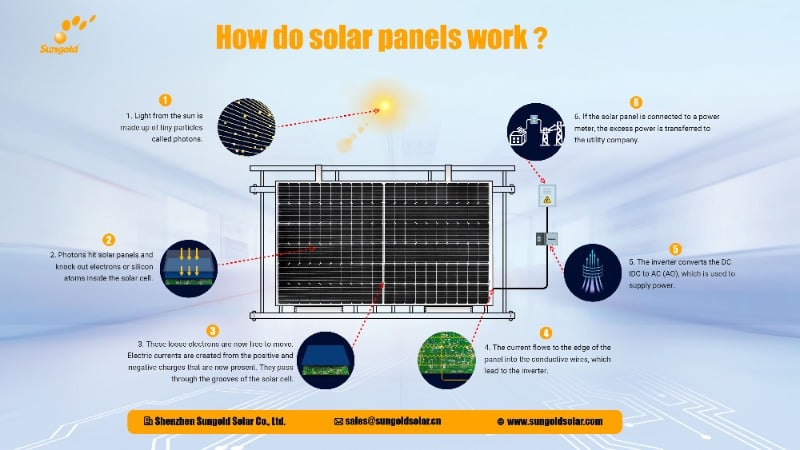
Components of a Solar Kit
To understand how a solar kit works, it’s essential to familiarize yourself with its key components: the grid, micro-inverter, stars, and Aug. These include:
-
Solar Panels: The heart of any solar kit is the collection of photovoltaic (PV) panels. These panels are essential for harnessing the power of the sun and converting it into electricity. They form the foundation of a grid-connected or off-grid solar system. With the help of micro inverters, solar panels can efficiently convert sunlight into usable energy. These inverters play a crucial role in optimizing the performance of the panels by ensuring that each panel operates at its maximum potential. So, whether you’re looking to power your home or business, invest in high-quality solar These solar panels consist of multiple interconnected solar cells that convert sunlight into electricity through the photovoltaic effect. They are used in a grid system and are equipped with micro inverters to optimize energy production. The panels are designed to harness the power of the sun, just like stars in the sky. To enhance their performance, they can be installed on rooftops or other surfaces using an aug.
-
Inverter: Solar panels produce direct current (DC) electricity, which needs to be converted into alternating current (AC) before it can be used by most electrical appliances. The inverter is responsible for converting the DC electricity from the solar panels into AC electricity that can be used on the grid and by micro inverters. This conversion process ensures that the energy generated by the solar panels can power homes and businesses, allowing them to utilize the stars as a renewable energy source. Additionally, the inverter plays a crucial role in optimizing the performance of solar systems by regulating the flow of electricity and providing important data for monitoring and maintenance purposes. The solar panel systems’ inverter performs this crucial function by converting solar energy’s DC power into AC power for grid connection, maximizing solar panel output.
-
Charge Controller: In off-grid solar kits or those with battery storage, a charge controller regulates the amount of charge going into the batteries to prevent overcharging or damage to the battery bank. This includes monitoring the output of the microinverter and ensuring it is compatible with the battery system. The charge controller also plays a crucial role in optimizing the performance of the solar system by effectively managing the charging process. It acts as a bridge between the solar panels and the batteries, ensuring that the energy generated by the solar panels is efficiently stored and utilized. The charge controller is like the aug that guides and controls the flow of energy, making sure that it is properly harnessed
-
Solar panels need to be securely mounted on rooftops or other suitable surfaces using a grid mounting system to maximize their exposure to sunlight. This ensures that the panels are positioned correctly and efficiently capture the energy from the stars. The use of a micro mounting system is essential for stability, preventing any damage or movement. By utilizing an aug mounting system, the solar panels remain securely in place, optimizing their performance and overall efficiency. The mounting system for solar power systems ensures stability and proper orientation for optimal energy production on the grid.
-
Wiring and Connectors: Various cables and connectors are used to interconnect all components within the micro solar kit, allowing for seamless energy flow between them in the grid.
Solar Battery
Solar battery is an essential component of a solar panel system. It plays a crucial role in storing the energy generated by the solar panels during the day, allowing you to use it at night or during periods of low sunlight.
Benefits of Solar Batteries
-
Energy Independence: One of the key advantages of having a solar battery is that it provides you with energy independence. By storing excess electricity produced by your solar panels, you can rely less on the grid and have power even during outages or when utility rates are high.
-
Maximize Self-Consumption: With a solar battery, you can maximize self-consumption of the energy you generate. Rather than sending surplus electricity back to the grid, which often results in minimal compensation, you can store it for later use when your energy demand exceeds what your solar panels produce.
-
Time-of-Use Optimization: Many regions have time-of-use (TOU) pricing structures where electricity costs for solar power vary depending on the time of day. Solar batteries allow you to take advantage of lower-priced electricity by charging during off-peak hours and using stored energy during peak-rate periods.
-
Backup Power: During power outages, having a solar battery ensures that critical appliances and devices remain operational. Whether it’s keeping your refrigerator running or powering medical equipment, a reliable backup power source can be invaluable in emergencies.
-
Reduced Carbon Footprint: Incorporating a solar battery into your system allows for greater utilization of clean, renewable energy.
Inverter
So you’ve decided to invest in solar panel kits for your home. Great choice! Solar panels are an excellent way to harness the power of the sun and reduce your reliance on traditional energy sources. But what about the inverter? This crucial component plays a vital role in converting the direct current (DC) electricity generated by your solar panels into alternating current (AC) electricity that can be used to power your home. Let’s take a closer look at why the inverter is such an important part of your solar panel system.
What Does an Inverter Do?
In simple terms, an inverter is responsible for transforming the DC electricity produced by your solar panels into AC electricity that can be used to power your appliances and electronics. Without an inverter, the energy generated by your solar panels would be unusable. The solar power inverter ensures that the electricity flows smoothly throughout your home, matching the voltage and frequency requirements of standard household appliances.
Types of Inverters
There are several types of inverters available for residential solar panel systems. Each type has its own unique advantages and considerations:
-
String Inverters: These are the most common type of inverters used in residential installations. They are cost-effective and reliable, capable of handling a string or series of connected solar panels.
-
Microinverters: Unlike string inverters, microinverters are installed on each individual solar panel. This allows for greater flexibility and efficiency, as each panel operates independently. Microinverters also mitigate any potential issues with shading or mismatched panels.
-
Power Optimizers: Similar to microinverters, power optimizers are installed at each panel but work differently.
Cables
One crucial component that often gets overlooked is the cables. These seemingly insignificant wires play a vital role in ensuring the smooth operation and efficiency of your solar power system. Let’s dive into why cables are so important and what you need to consider when selecting the right ones for your setup.
The Power Highway: Cables in Solar Panel Kits
Cables act as the power highway, connecting various components of your solar panel system. They carry the electricity generated by the panels to the charge controller, battery bank, and ultimately, your appliances or grid connection. Just like a well-maintained road ensures a smooth journey, high-quality cables ensure an efficient flow of electricity without any significant losses.
-
Size Matters:Size does matter! The cable’s size determines its ability to handle current without overheating or experiencing voltage drops. A larger wire gauge can carry more current with minimal resistance compared to a smaller gauge wire. Therefore, it is essential to choose cables with an appropriate size based on your system’s voltage and current requirements.
-
Copper vs. Aluminum: Copper and aluminum are the two most commonly used materials for solar panel kit cables due to their excellent conductivity properties. Copper offers superior electrical conductivity but tends to be more expensive than aluminum. On the other hand, aluminum is relatively cheaper but has slightly higher resistance compared to copper. Consider factors such as budget and specific project needs when deciding between these two options.
-
UV Resistance: Solar panels are typically installed outdoors where they are exposed to sunlight constantly.
Mounting Hardware
Mounting hardware is an essential component of solar panel kits. It plays a crucial role in securely attaching the panels to different surfaces, ensuring optimal performance and durability. Without proper mounting hardware, solar panels may not be able to withstand harsh weather conditions or maintain their position, leading to potential damage or reduced efficiency.
Types of Mounting Hardware
-
Racking Systems: Racking systems are commonly used for mounting solar panels on rooftops. These systems provide a sturdy framework that supports the panels and allows for easy installation and maintenance. They come in various designs, including flush mounts, ballasted mounts, and tilt-up mounts, catering to different roof types and orientations.
-
Ground Mounts: Ground mounts are ideal for situations where rooftop installations are not feasible or when there is ample space available on the ground. These mounts offer flexibility in terms of positioning and can be adjusted for optimum sun exposure. They usually consist of metal frames anchored into the ground to hold the solar panels securely.
-
Pole Mounts: Pole mounts are suitable for installations where solar panels need to be elevated off the ground or mounted on poles or vertical structures such as fences or streetlights. These mounts provide stability while allowing easy adjustment of panel angles for maximum energy capture.
Considerations When Choosing Mounting Hardware
When selecting mounting hardware for your solar panel kit, several factors should be taken into account:
-
Roof Type: The type of roof you have will determine the appropriate racking system to use. For example, if you have a flat roof, a ballasted mount may be more suitable than a flush mount.
-
Weight Capacity
Types of Solar Panels
Rigid Solar Panels
Rigid solar panels are a popular choice for those looking to harness the power of the sun and generate clean, renewable energy. These panels offer a range of benefits and features that make them an attractive option for both residential and commercial use.
Durability
Durability is key. Rigid solar panels are known for their sturdy construction and ability to withstand various weather conditions. Made with high-quality materials such as tempered glass and aluminum frames, these panels can handle hail, heavy snow loads, and even strong winds. This durability ensures that your investment will last for years to come without compromising on performance.
Efficiency
One of the primary factors to consider when choosing solar panels is their efficiency in converting sunlight into electricity. Rigid solar panels excel in this area, offering high conversion rates that maximize energy production. With advancements in technology, these panels have become more efficient than ever before, allowing you to generate more power from a smaller surface area.
Versatility
Rigid solar panels come in a variety of sizes and wattages, making them suitable for various applications. Whether you want to install them on your rooftop or mount them on the ground, there is a size that fits your needs. These panels can be used in both grid-tied and off-grid systems, providing flexibility based on your specific requirements.
Easy Installation
Installing rigid solar panels is relatively straightforward and can often be done as a DIY project. Most kits come with detailed instructions that guide you through the installation process step by step.
-
-
Portable Solar Panels
Portable solar panels have become increasingly popular in recent years, offering a convenient and environmentally-friendly way to harness the power of the sun. These compact and lightweight devices provide a portable source of clean energy that can be used for various purposes, from outdoor adventures to emergency situations.
Versatility
One of the key advantages of portable solar panels is their versatility. These handy devices can be used in a wide range of scenarios, making them an excellent investment for anyone seeking an off-grid power solution. Whether you’re camping in the wilderness, traveling in an RV, or simply enjoying a day at the beach, portable solar panels offer a reliable source of electricity wherever you go.
Convenience
Gone are the days when you had to rely solely on traditional power sources while on the move. Portable solar panels eliminate the need for bulky generators or access to electrical outlets by harnessing sunlight directly. They are designed with convenience in mind, featuring foldable designs and lightweight materials that make them easy to carry and set up. With a portable solar panel kit, you can enjoy electricity without any hassle or dependency on grid infrastructure.
Energy Independence
In today’s world, where energy prices continue to rise and concerns about climate change grow stronger, achieving energy independence has become crucial. Portable solar panels empower individuals to generate their own clean energy without relying on fossil fuels or centralized power grids. By investing in a high-quality solar panel kit, you can not only reduce your carbon footprint but also take control over your energy consumption and costs.
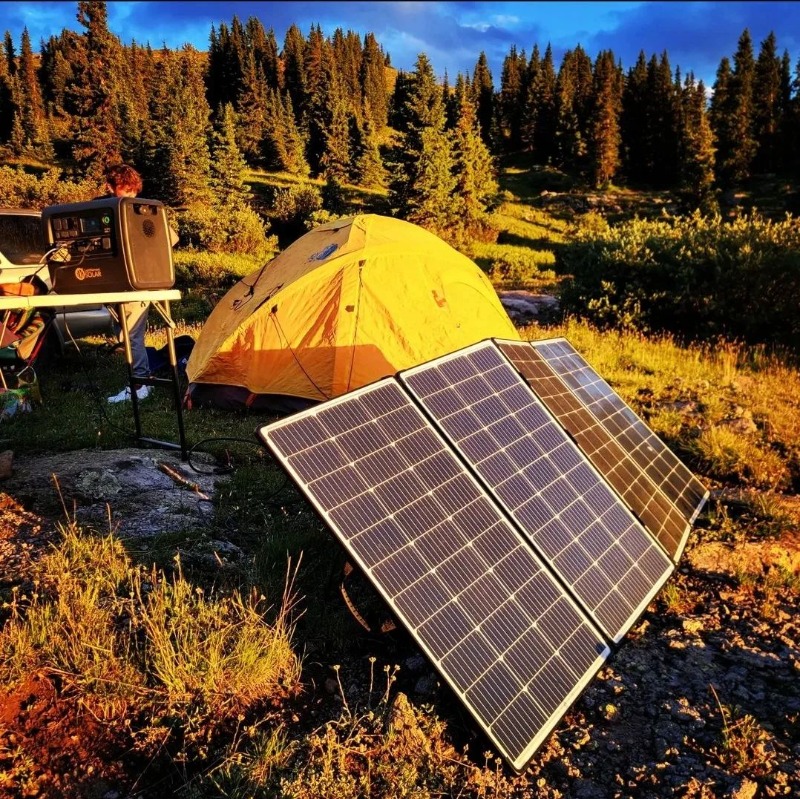
Flexible Solar Panels
Flexible solar panels are a game-changer in the world of renewable energy. These innovative panels offer a range of benefits and possibilities that traditional rigid solar panels simply cannot match. Whether you’re looking to power your RV, boat, or even your backpacking adventures, flexible solar panels provide a lightweight, portable, and efficient solution.
Versatility at Its Finest
With flexible solar panels, versatility takes center stage. Unlike their rigid counterparts, these panels can be easily bent and molded to fit curved surfaces. This opens up a whole new world of possibilities for installation options. Imagine being able to mount solar panels on an irregularly shaped roof or even on the side of a vehicle without compromising efficiency! The flexibility allows for seamless integration into various structures and surfaces, making them ideal for unconventional settings.
Lightweight and Portable Powerhouses
One of the key advantages of flexible solar panels is their lightweight nature. Traditional solar panels can be heavy and cumbersome to transport. However, with flexible models, you can enjoy the benefits of renewable energy on-the-go. These lightweight powerhouses are perfect for outdoor enthusiasts who want to charge their devices while hiking or camping. Simply roll them up or fold them neatly into your backpack without adding unnecessary bulk.
Endless Applications
The applications for flexible solar panels are virtually limitless. Here are just a few examples:
Cost Savings: One of the primary reasons people choose to build their own solar panel kit is to save money. By purchasing individual components and assembling them yourself, you can avoid labor costs associated with professional installation. Customization: Building your own solar panel kit allows you to tailor it specifically to meet your energy needs. You have the freedom to choose the size and number of panels based on your available space and desired energy output. Learning Experience: Embarking on a DIY solar project provides an excellent opportunity for learning about renewable energy systems. It allows you to gain hands-on experience while understanding how each component works together to generate clean electricity.Recreational Vehicles (RVs): Flexible solar panels are an excellent choice for RV owners looking to harness the power of the sun while traveling off-grid. They can be easily mounted on curved surfaces such as RV roofs.
Is It Possible to Build Your Own Solar Panel Kit? — DIY Solar
Yes, You Can Do It Yourself!
So you’re interested in harnessing the power of the sun and saving some money on your energy bills. The good news is that building your own solar panel kit is not only possible but also an exciting project that can be accomplished with a little bit of time, effort, and dedication. With the right guidance and resources, you can become a solar enthusiast and take control of your energy consumption.
What Are Solar Panel Kits?
Before we dive into the nitty-gritty details of building your own solar panel kit, let’s first understand what it actually entails. Solar panel kits are packages that contain all the necessary components to generate electricity from sunlight. They typically include solar panels, inverters, mounting hardware, wiring, and sometimes even batteries for storing excess energy.
Benefits of Building Your Own Solar Panel Kit
Compatibility
What solar panel kits are compatible with?
Compatibility is a crucial factor to consider. You want to make sure that the kit you choose is compatible with your specific needs and requirements. Let’s dive into the various aspects of compatibility.
1. Roof Type
The first thing you need to consider is the type of roof you have. Solar panels can be installed on different types of roofs, such as asphalt shingles, metal roofs, tile roofs, or flat roofs. Each roof type may require specific mounting equipment or installation techniques. It’s essential to choose a solar panel kit that is designed for your particular roof type to ensure proper installation and maximum efficiency.
2. Power Output
Another aspect of compatibility is the power output of the solar panel kit. The power output determines how much electricity the panels can generate under optimal conditions. Different kits have different power ratings, usually measured in watts (W). Consider your energy consumption and determine how much electricity you need from your solar panels. Ensure that the kit you choose can meet your energy demands effectively.
3. Inverter Compatibility
Solar panels produce direct current (DC) electricity, but most household appliances and electrical systems use alternating current (AC). To convert DC electricity into AC electricity, an inverter is required. When selecting a solar panel kit, ensure that it is compatible with inverters available in the market or includes an inverter that meets your needs.
4. Battery Storage
If you’re interested in storing excess energy produced by your solar panels for later use, battery storage compatibility becomes important.
Quality
Quality is of utmost importance. You want to ensure that the kit you choose is reliable, durable, and capable of generating efficient solar energy for years to come. Here are some key factors to consider when evaluating the quality of solar panel kits:
Longevity
You don’t want to invest in a solar panel kit that will wear out or become inefficient within a few years. Look for kits that are built with high-quality materials and have a proven track record of longevity. Consider the warranty offered by the manufacturer as an indicator of their confidence in the product’s durability.
Efficiency
The efficiency of a solar panel kit determines how effectively it can convert sunlight into electricity. Higher efficiency means more power generation, which translates into greater savings on your energy bills. Look for kits with high-efficiency panels that can harness maximum energy from the sun.
Durability
Solar panels are exposed to various weather conditions throughout their lifespan. A quality solar panel kit should be able to withstand harsh environments such as extreme temperatures, heavy rain, and strong winds without deteriorating in performance or structural integrity. Check if the panels are certified for durability standards and have adequate protection against corrosion.
Performance Under Low Light Conditions
Solar panels rely on sunlight to generate power, but they should also perform well under low light conditions such as cloudy days or early morning/evening hours. Kits with advanced technologies like bypass diodes can optimize power output even when parts of the panel are shaded.
Conclusion
Assembly is a crucial step. By understanding how the kit works and familiarizing yourself with the components such as solar panels, batteries, inverters, cables, and mounting hardware, you can confidently embark on assembling your own solar panel kit. Whether you choose rigid, portable, or flexible panels depends on your specific needs and preferences. DIY solar panel kits are also an option if you’re up for the challenge. Remember to ensure compatibility and prioritize quality when selecting your components.
Now that you have a good grasp of the assembly process for solar panel kits, it’s time to take action! Start exploring different options for solar panel kits that suit your requirements and budget. With the right kit in hand, you’ll be well on your way to harnessing clean energy from the sun while reducing your carbon footprint. Don’t wait any longer – start building your sustainable future today!


